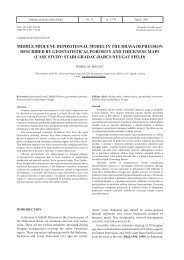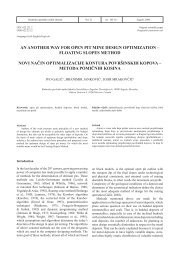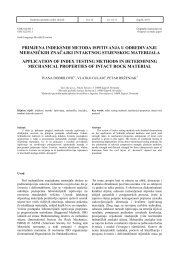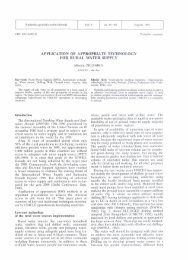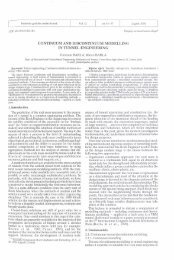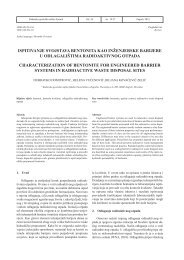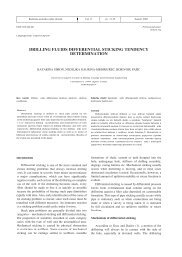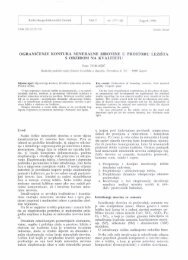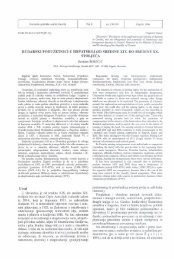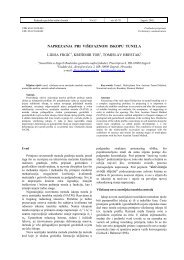quarry stability analysis for complex slip surfaces using the ...
quarry stability analysis for complex slip surfaces using the ...
quarry stability analysis for complex slip surfaces using the ...
Create successful ePaper yourself
Turn your PDF publications into a flip-book with our unique Google optimized e-Paper software.
92<br />
range of input parameters that exist <strong>for</strong> a particular site.<br />
With <strong>the</strong> aim of solving <strong>the</strong> rock slope <strong>stability</strong> problems<br />
more successfully, <strong>the</strong> numerical research in developing<br />
<strong>the</strong> estimation method named MathSlope has been<br />
undertaken (Hrženjak, 2004).<br />
The MathSlope method<br />
The method and algorithm named MathSlope has been<br />
developed with <strong>the</strong> aim of calculating <strong>the</strong> <strong>stability</strong> factor<br />
of rock slopes <strong>for</strong> <strong>complex</strong> shapes of <strong>slip</strong> <strong>surfaces</strong>. The<br />
algorithm MathSlope has been created by <strong>the</strong> program<br />
Ma<strong>the</strong>matica in <strong>the</strong> <strong>for</strong>m of an added package (Hrženjak<br />
et al., 2003). The setting up and searching procedure of<br />
critical <strong>slip</strong> surface of <strong>complex</strong> shape is very different in<br />
<strong>the</strong> MathSlope method than in o<strong>the</strong>r ones. The setting up<br />
of <strong>the</strong> <strong>slip</strong> surface is carried out in two steps. In <strong>the</strong> first<br />
step <strong>the</strong> basic shape of <strong>the</strong> <strong>slip</strong> surface is <strong>for</strong>med, whereas<br />
in <strong>the</strong> second, with <strong>the</strong> introduction of discontinuity<br />
<strong>surfaces</strong>, <strong>the</strong> <strong>complex</strong> shapes of <strong>the</strong> <strong>slip</strong> surface are<br />
Rud.-geol.-naft. zb., Vol. 16, Zagreb, 2004.<br />
P. Hrženjak: Quarry <strong>stability</strong> <strong>analysis</strong> <strong>for</strong> <strong>complex</strong> <strong>slip</strong> <strong>surfaces</strong>...<br />
created. The basic assumption in this method is that all<br />
<strong>slip</strong> <strong>surfaces</strong> have a concave shape.<br />
The <strong>slip</strong> surface is defined by <strong>the</strong> point of exit of <strong>the</strong><br />
<strong>slip</strong> surface at <strong>the</strong> toe of <strong>the</strong> slope, <strong>the</strong> angle of secant<br />
and angles of deviation of <strong>slip</strong> surface from secant on top<br />
and at <strong>the</strong> toe of <strong>the</strong> slope. These angles actually define<br />
tangents to <strong>the</strong> <strong>slip</strong> surface (fig. 1).<br />
The discontinuities can be introduced as “floating”<br />
and “positioned”. The “floating” discontinuities mean<br />
that discontinuities will be added to each <strong>slip</strong> surface at<br />
<strong>the</strong> point that has <strong>the</strong> same inclination as <strong>the</strong> inclination<br />
of <strong>the</strong> discontinuities. The discontinuities will be added<br />
to <strong>the</strong> <strong>slip</strong> surface in length of persistence that has been<br />
given as input data. The “positioned” discontinuity means<br />
that discontinuity surface will be added according to<br />
<strong>the</strong> position on <strong>the</strong> slope. The “floating” discontinuities<br />
refer to sets of discontinuities which represent structural<br />
domains, unlike <strong>the</strong> “positioned” ones, which refer to<br />
individual or major structures such as contacts, faults and<br />
shear zones.<br />
Figure 1. Setting up a <strong>complex</strong> shape of <strong>the</strong> <strong>slip</strong> surface<br />
Slika 1. Postava klizne plohe složenog oblika<br />
The procedure of searching <strong>for</strong> <strong>the</strong> critical <strong>slip</strong> surface<br />
can be carried out through setting up of a large number<br />
of assumed <strong>slip</strong> <strong>surfaces</strong> and <strong>the</strong> iterative method. In<br />
<strong>the</strong> first method one or more areas <strong>for</strong> <strong>the</strong> searching of<br />
a <strong>slip</strong> surface <strong>for</strong> every slope may be assigned. The area<br />
of searching comprises of <strong>the</strong> coordinates of <strong>the</strong> points<br />
on <strong>the</strong> top of <strong>the</strong> slope that assigns <strong>the</strong> range of angle<br />
deviation of <strong>the</strong> secant and point of exit of <strong>the</strong> <strong>slip</strong> surface.<br />
The shape of <strong>the</strong> <strong>slip</strong> surface starts from <strong>the</strong> straight line<br />
that actually presents <strong>the</strong> secant across different twisted<br />
shapes within <strong>the</strong>oretical possible angles of <strong>slip</strong> surface.<br />
The step of changes of all angles may be arbitrarily<br />
chosen. In this way <strong>the</strong> number of possible <strong>the</strong>oretical<br />
combinations of shapes of <strong>the</strong> <strong>slip</strong> <strong>surfaces</strong> may be<br />
generated. In <strong>the</strong> iterative method <strong>the</strong> shape and position<br />
of <strong>the</strong> <strong>slip</strong> surface is changed gradually until a minimum<br />
value of <strong>the</strong> <strong>stability</strong> factor is obtained. In combining<br />
<strong>the</strong>se two procedures critical <strong>slip</strong> surface of <strong>complex</strong><br />
shape can successfully be found. As in o<strong>the</strong>r methods <strong>the</strong><br />
critical <strong>slip</strong> surface is a <strong>slip</strong> surface with <strong>the</strong> lowest factor<br />
of <strong>stability</strong>.<br />
The <strong>stability</strong> factor, as in o<strong>the</strong>r methods, is defined as<br />
<strong>the</strong> ratio of <strong>the</strong> summation of <strong>the</strong> available resisting shear<br />
<strong>for</strong>ce (S r<br />
) along a <strong>slip</strong> surface to <strong>the</strong> summation of <strong>the</strong><br />
mobilized shear <strong>for</strong>ce along a <strong>slip</strong> surface (S m<br />
).<br />
.<br />
(1)



